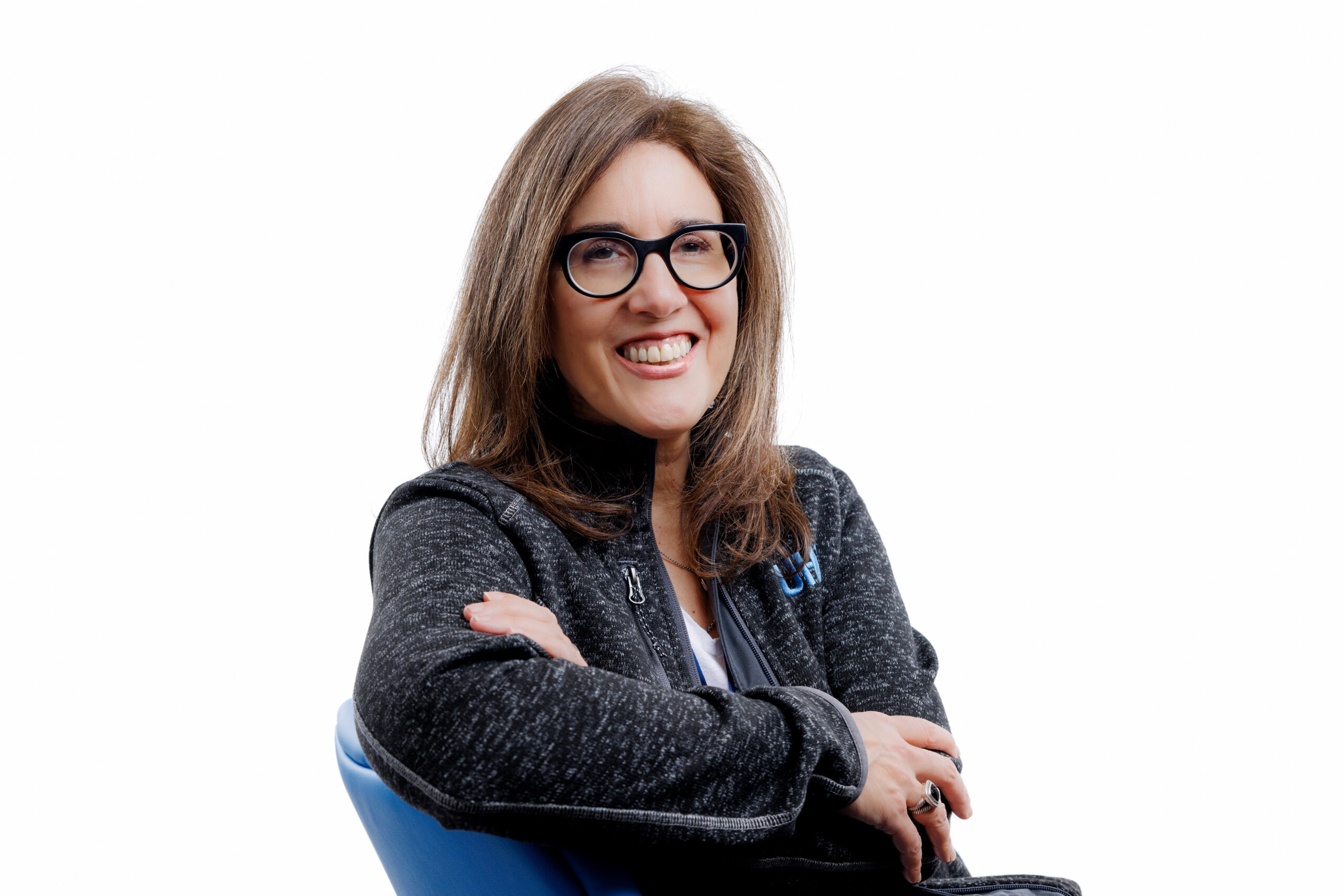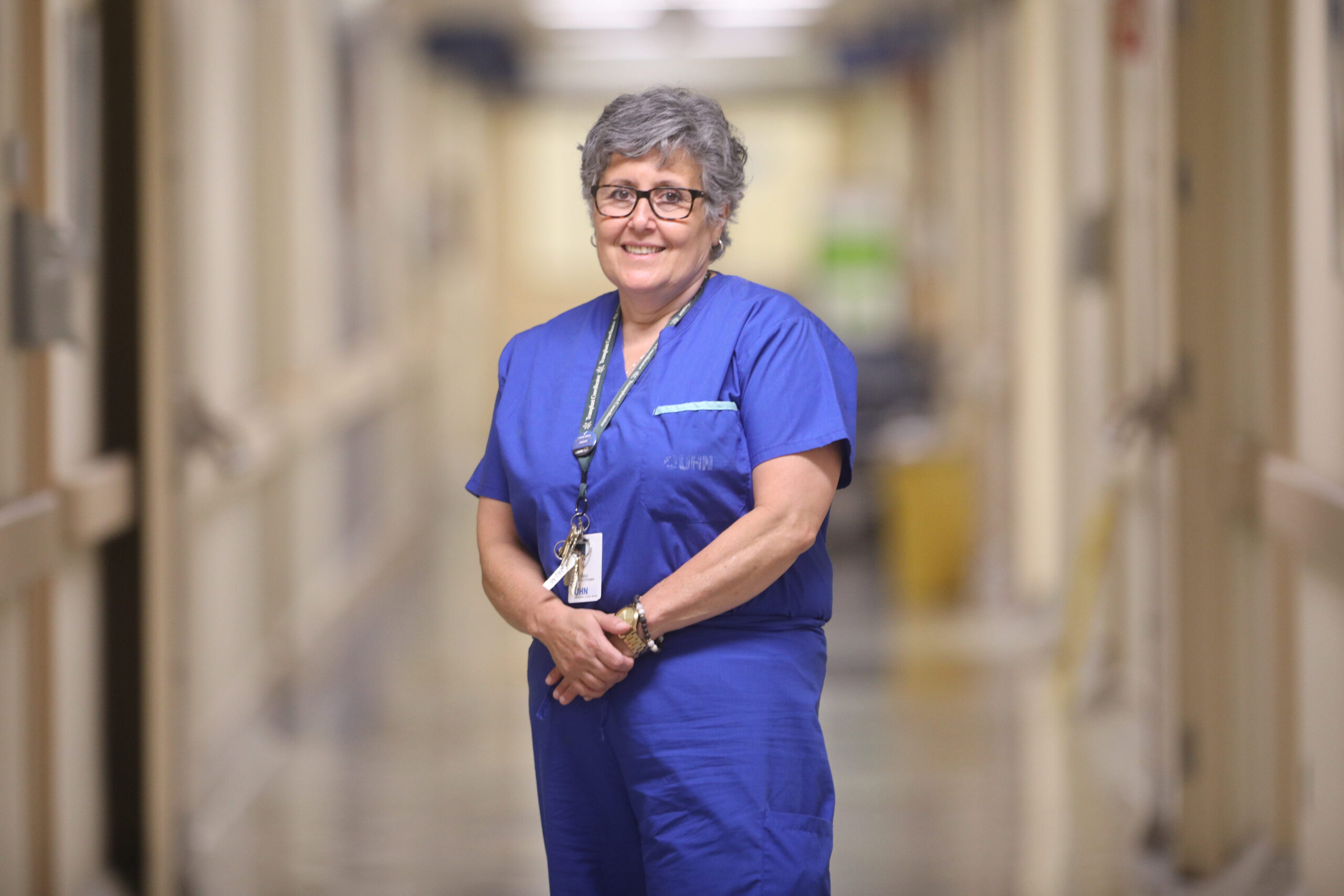
Dr. Yas Moayedi (right) believes technology is key to being adaptive and delivering the best possible outcomes for people living with heart failure.
Tim Fraser
Empowering patients through digital care
Innovation and a small but mighty team at the Peter Munk Cardiac Centre are helping patients with heart failure stay on track with their treatment.
When it comes to treating heart failure, most people wouldn’t think smartphone apps could play much of a role. But that’s not the case at University Health Network’s Peter Munk Cardiac Centre, where a personalized app, coupled with careful, remote monitoring by clinicians, is helping to increase patient adherence to key medications while curbing side effects.
For most patients diagnosed with heart failure, taking a specific, standardized combination of prescribed drugs can profoundly enhance and prolong quality of life. Known as guideline-directed medical therapy (GDMT), this specific combination has been proven through research to improve patient outcomes while providing practitioners with a foundation for treatment. Typically, cardiologists using GDMT prescribe drugs from various classes of medication that support the heart and help control symptoms in specific ways.
Mineralocorticoid receptor antagonists (MRAs) are a certain drug class used to treat heart failure that help block hormones putting stress on the heart. They also help rid the body of extra fluid.

But for all the positive attributes, MRAs have a common, concerning side effect: they can raise a patient’s potassium to dangerously high levels, which can lead to abnormal heart rhythm. Because of this, a proportion of patients cannot be on optimized doses. Some clinicians avoid starting on MRAs altogether because of this side-effect. This is a problem, as evidence has shown MRAs play an important role in managing heart failure and keeping patients out of hospital.
1,540+
More than 1,540 patients have enrolled in Peter Munk Cardiac Centre’s Medly program since 2016. The Medly team currently manages alerts for more than 800 patients living with heart failure or reduced heart function.
In January 2022, Drs. Yas Moayedi and Juan Duero Posada, both cardiologists and heart failure specialists at the Peter Munk Cardiac Centre, started investigating just how many patients were taking MRAs as part of their regimen.
“In a weekly audit, we found that 40-50 per cent of patients with reduced ejection fraction were either not prescribed or on a suboptimal dose of an MRA,” says Dr. Moayedi. “While this is better than real world data, there is opportunity here!”
As a first step to increasing MRA adherence, Drs. Moayedi and Posada gathered a team to generate and implement strategies for getting patients on MRA medication while keeping their potassium levels within normal range.
Remote monitoring, customized care
In every facet of patient care, the Peter Munk Cardiac Centre embraces a collaborative, interdisciplinary approach to solve problems, advance understanding and improve patient outcomes. It was no different when Drs. Moayedi and Posada assembled their small but mighty team to increase MRA adherence by bringing together the expertise of nurse practitioner Stella Kozuszko, registered dietitian Margaret Brum and a powerful digital resource known as Medly.
“Medly is a mobile monitoring platform our heart failure patients have access to,” explains Kozuszko, whose primary role is in the Medly Program. “We set up a patient’s Medly account so they can enter daily information, like their weight and blood pressure and symptoms, allowing nurses to monitor their conditions from afar.”
“Technology is the equalizer and key to being adaptive and providing patients with tailored care.”
Dr. Yas Moayedi
50%
A 50 per cent decrease was seen in rehospitalizations among heart failure patients who used Medly compared to those who didn’t use the platform.Journal of Medical Internet Research
Developed by the Peter Munk Cardiac Centre in 2016, Medly gives clinicians remote access to continuous data, providing a well-rounded picture of a patient’s clinical status through readings such as blood pressure and heart rate, as well as recent lab results, current medications and more.
Drs. Moayedi and Posada knew they could leverage Medly for MRA adherence since the platform allows for very close monitoring and could be used to track the potassium level of a patient starting on MRA medication, making it easier to adjust the dosage should potassium levels begin to rise.
“Technology is the equalizer and key to being adaptive and providing patients with tailored care,” says Dr. Moayedi.
Along with the use of Medly, the team developed a second strategy for optimizing MRA adherence: prior to optimizing the MRA dose, each patient would undergo a rigorous consultation with Brum, during which she would examine each patient’s diet, then educate them on how their food choices affect their potassium levels.
With these new plans in place, word spread across the Peter Munk Cardiac Centre informing clinicians that if they had patients who were not optimized on MRAs due to high potassium, there was a new, interventional initiative that might help them get back on track.
Soon, more than 50 patients living with heart failure were enrolled in the initiative – and the team’s new strategies became a reality.

The plan in action
The team nicknamed their project SnakChat – a playful nod to a popular social media app centred on users sharing everyday moments via short-lasting photos and videos. For SnakChat, patients share photos as well. In fact, it’s one of the first things asked of them after their initial consultation with Brum.
+80%
Through the SnakChat project, MRA adherence levels for patients at the Peter Munk Cardiac Centre with heart failure have risen from approximately 35 per cent to more than 80 per cent.
“During that initial nutrition assessment, I look into all the sources of potassium in a patient’s diet and suggest low-potassium alternatives,” says Brum. “Then I ask them to download an external app that tracks what they eat.”
Patients take pictures of their meals for three days using the app RXFood, which uses artificial intelligence to interpret the information in the photos to measure the amount of potassium found in every item, and categorizes foods as high and low potassium containing in a report. This not only gives Brum deeper insight into where a patient’s sources of potassium are coming from, allowing her to provide further guidance on potassium-reduced alternatives, it also allows patients to play an active role in their treatment plan.
“Through the use of a multi-disciplinary approach we are able to get most patients on their guideline-directed therapy.”
Stella Kozuszko
Once a patient’s dietary consultations are complete, and blood work confirms their potassium level is low enough, they are put on the MRA medication and monitored closely through Medly by nurses, and the SnakChat team.
“The team meets weekly to review each patient – where their potassium is sitting, what kind of changes were made and whether they’re doing well with their diet,” says Brum.
A collaborative relationship between the SnakChat team and each patient’s primary clinician ensures that if a patient’s potassium levels rise, the clinician can either adjust the MRA dosage or introduce a separate medication to help lower potassium.
“Through the use of a multi-disciplinary approach – which in this case includes an overseeing dietitian and nurses monitoring their patients on Medly – we were able to get most patients on their guideline-directed therapy,” says Kozuszko.
“We’re a state-of-the-art centre and we’re driving disruptive technology in health care.”
Dr. Yas Moayedi
Indeed, through the SnakChat project, which has evolved the paradigm of care to a more circular, multidisciplinary approach, MRA adherence levels at the Peter Munk Cardiac Centre have risen from approximately 35 per cent to more than 80 per cent.
Up next, says Dr. Moayedi, is comparing the positive outcomes of this project to a broader standard of care, all while continuing to deliver the best possible outcomes for people living with heart failure.
“This is just the beginning,” says Kozuszko. “It’s a step to bigger things.”
Dr. Moayedi echoes, “We’re a state-of-the-art centre and we’re driving disruptive technology in health care.”

